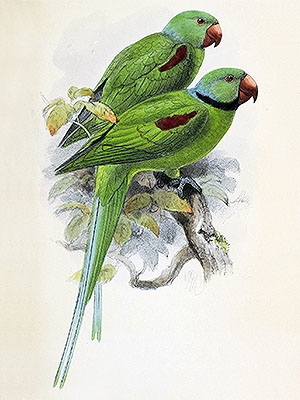Seychelles Parakeet (Palaeornis wardi)
The Seychelles Parakeet was described in 1867, it was already very rare at that time and restricted to only two islands in the Seychelles, Mahé and Silhouette, it might formerly have occurred on all of the islands.
The species was closest related to the Alexandrine Parakeet (Palaeornis eupatria (L.)) from which it differed mainly by the lack of a rose-colored neck collar; it was formerly also merged with that species.
The Seychelles Parakeet was last recorded in 1883 when the last known specimen died in captivity, the species died out because it was heavily hunted for being a ‘pest’ to crops.
Marianne North, a botanical artist, depicted a live pair of this species on the island of Mahé when she visited the family of Dr. James Brooks, a colonial medical officer on the Seychelles. She also wrote some notes about these two birds:
“He and his Greek wife were very kind and hospitable in their offers to me. I went one day to their house, and painted their parrots, which came originally from Silhouette: queer, misshapen birds, with enormous beaks and patches of red and yellow badly put on, one of them having a black ring round its neck. Both were quite helplessly bullied by common pigeons, which came and ate up their food, while they jabbered in a melancholy way, and submitted. They had absolutely no tops to their heads, which perhaps accounted for their stupidity. They had a stand on the back verandah, where they slept and were fed. They were not tied up, but went and stole their own fruit off the neighbouring trees.” [1]
*********************
References:
[1] Anthony S. Cheke: Animals depicted by Marianne North in her Seychelles paintings. Phelsuma 21: 47-57. 2013
[2] Michael P. Braun; Thomas Datzmann, Thomas Arndt; Matthias Reinschmidt; Heinz Schnittker; Norbert Bahr; Hedwig Sauer-Günth; Michael Wink: A molecular phylogeny of the genus Psittacula sensu lato (Aves: Psittaciformes: Psittacidae: Psittacula, Psittinus, Tanygnathus, †Mascarinus) with taxonomic implications. Zootaxa 4563(3): 547-562. 2019
*********************

(not in copyright)
*********************
edited: 14.06.2020
